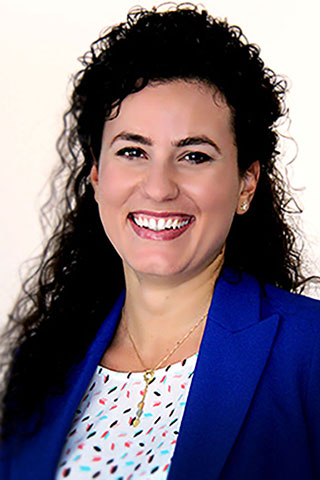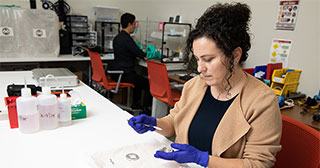October 28, 2022

Through her research on air pollution, Rima Habre, Sc.D., of the University of Southern California (USC), wants to learn exactly what pollutants are in the air, their quantities, and whether exposures to such contaminants can be linked to health effects.
Habre has always been passionate about nature, the environment, and human health. As a child in Lebanon, she witnessed the effects of climate and pollution on water quality and resources in her community firsthand.
Later, while working toward her doctoral degree at the Harvard T.H. Chan School of Public Health, her mentor Petros Koutrakis, Ph.D., showed her the importance of studying harmful chemicals in the air.
“The complexity of these exposures drew me in,” Habre said. “How they can differ from place to place, even neighborhood to neighborhood, represents a unique challenge.”
Today, Habre is the director of exposure assessment at the USC Maternal and Developmental Risks from Environmental and Social Stressors (MADRES) Center for Environmental Health Disparities, funded by NIEHS and the National Institute on Minority Health and Health Disparities. There, researchers are disentangling the effects of air pollution, wildfires, the built environment, and social stressors on maternal and child health.
Precision Environmental Health
Inspired by Koutrakis, Habre is using both aggregate data and daily-life information to build air pollution profiles and tailor them to individuals. Using a wide variety of tools, from GPS to sampling devices, Habre is integrating global, regional, local, and personal exposure pathways.
“Much of my work focuses on monitoring and modeling individual exposure among pregnant women and their children,” Habre explained. “It’s really important to capture neighborhood air pollution and even what’s in a person’s home — what they are immediately breathing — because it will often have a much more direct impact on their health than background air pollution.”
For instance, through data collected from wearable, personal air pollution and geolocation monitoring devices, Habre noted that low-income pregnant women spend less time in health-enhancing greenspaces. Also, low-income pregnant women are likely to commute on public transportation, which exposes them to more air pollution — including second-hand tobacco smoke encountered on streets and at bus or train stops — than women who travel by car.
Seeing trends like these has convinced Habre that researchers need more creative ways to look at exposures. That’s why some of the newer tools at her disposal excite her.
“By combining lots of different tools — like GPS tracking, time-activity surveys, indoor and personal environment measurements, and more — we can clearly see that what people do every day changes their exposure profiles,” Habre said. “When all the pieces fall together, we can begin connecting specific pollution sources to specific health effects.”
The Future Is Interdisciplinary

Habre is also passionate about nurturing the next generation of air pollution exposure and health experts and encouraging them to explore cross-disciplinary research.
“The students and post-docs are diverse, and that makes our work interdisciplinary,” Habre noted. “To do impactful work, you need to know how to talk to other disciplines and bring in outside expertise. I am just one person, but my doing cross-disciplinary research is a force multiplier.”
Recently, Habre has been motivated by the climate change angle in her work. She is interested in co-exposures and extreme events that occur with climate change. She sees many others in her field expanding their work from the local angle to include the global view, as well.
Through MADRES, Habre’s team is learning that women in southern California experience, on average, four months — and up to seven — of exposure to toxins and particulate matter from wildfire smoke during pregnancy. Early evidence from her research suggests negative effects on fetal growth.
“We can’t ignore the effects of climate change on our health,” she said. “Stepping back and taking a more global, holistic approach can illuminate connections and possibilities that researchers working in separate silos might not see.”
In Lebanon, Habre noted, wildfires are becoming more and more common as climate change affects the nation. She thinks the people of Lebanon are now more concerned about air pollution than in the past.
If she and other researchers can draw clearer lines between exposures and health outcomes, it will become easier to convince people everywhere to take air pollution seriously, according to Habre.
“Paying attention to air pollution is especially hard in communities that are already overburdened, and understandably so, but it is critical,” she said. “I want clean air to be considered a human right.”


